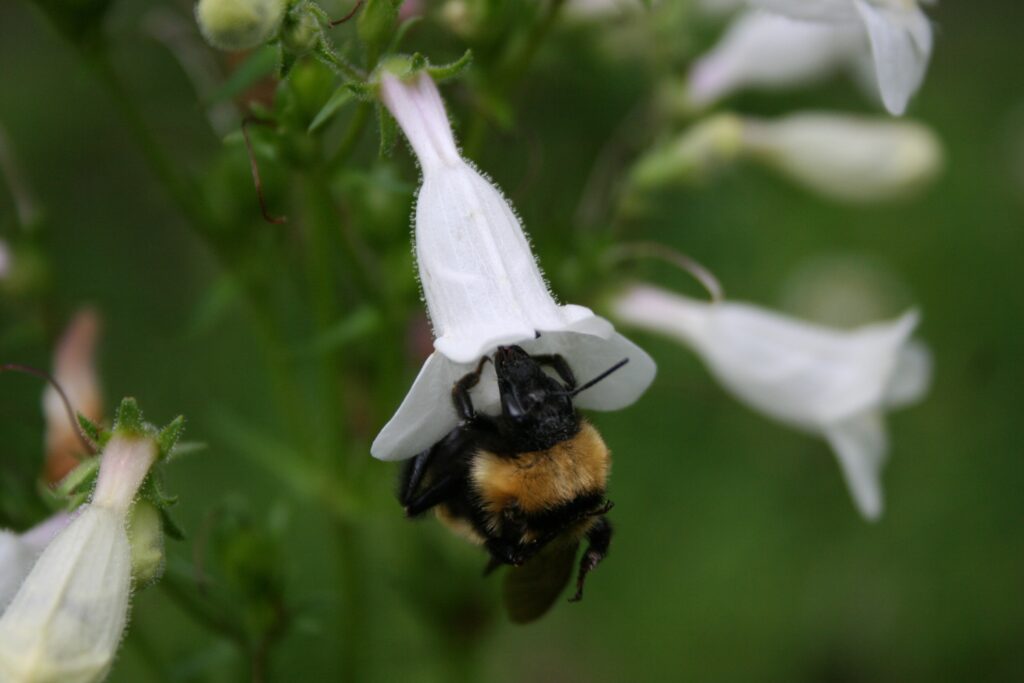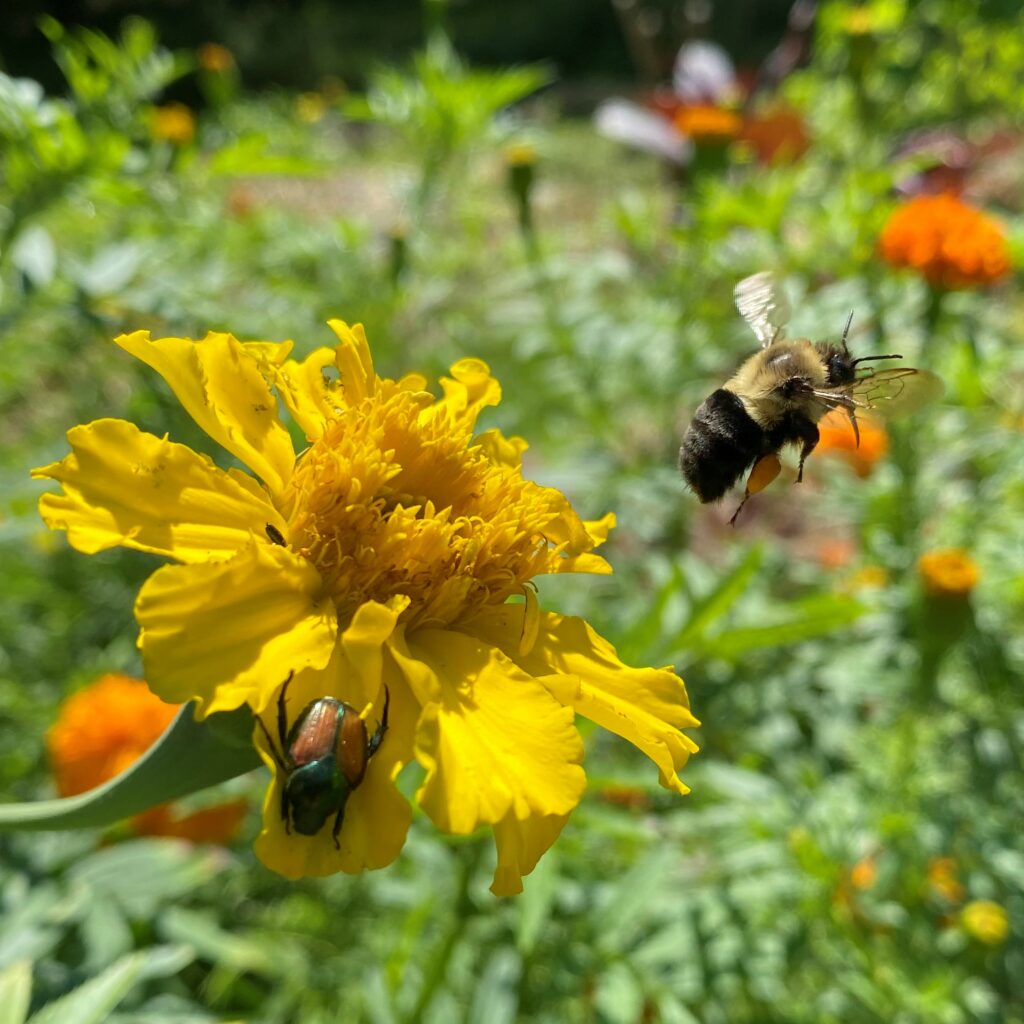by Sue Smith-Heavenrich
For the past 12 years I’ve kept track of the pollinators visiting my rural garden, counting the number of bees, wasps, flies and others that visit flowers. Each spring, things are quiet and I worry the bees won’t show up. But by July I see the glint of metallic sweat bees and shiny-butted carpenter bees in the flowers, and hear the distinct humming of various bumblebees.
Over those same 12 years many native bee populations have declined, including the once ubiquitous fuzzy yellow American bumblebee (Bombus pensylvanicus). So I took notice when a 2020 study claimed that city bees were faring better than their country cousins. I wondered whether they were counting the bees like I was.
It turns out the scientists were counting bees. But they were looking at other ways of determining bee success as well. Researchers in Germany compared bee activity in paired “flower-rich” study sites established in and around nine cities. They matched urban and rural locations in terms of land cover and flower abundance. For city sites, the researchers located their study plots in urban core areas surrounded by high road density and human infrastructure. Seven were in or close to botanical gardens, and two were in public parks. They set up the rural site areas where agriculture and forest or grassland cover were dominant land uses.

Then scientists visited each pair of sites for five consecutive days. They placed 10 potted red clover plants at each study site and observed the plants for 15 minutes at a time, monitoring insects at the flowers. They also set out pan traps — blue, yellow and white pans filled with soapy water — to sample flying insects that visited the site. After five days, they moved the clover plants to a greenhouse and allowed them to mature. They used seed set as a measure of pollination success.
While the scientists found a greater diversity of flying insects in the countryside, the clover flowers from urban sites had a higher pollination rate. Their prime pollinator: bumblebees, accounting for 75% of the recorded flower visits. Honeybees came in second, making up almost 9% of flower visits.
The diversity of flowers in parks and gardens — and even in untended vacant lots — provides a reliable food supply for bees in the city. But the German researchers believe that the bees are finding good nesting opportunities as well in exposed soils, dead wood and wall cavities. And, because of their orientation and learning skills, bees may be able to cope with the challenges of city life better than other insect pollinators.
Which begs the question: What’s going on with bees in the rural countryside? The researchers note that the types of nesting sites, gardens and hedges prevalent in urban areas are often missing in an agricultural landscape. Even if a farmer plants flower strips, cultivation and mowing disturb nesting sites as well as perennial nectar and pollen sources. Other studies have shown that bumblebees and other wild bees are susceptible to pesticides, which could explain low populations in rural areas.
Cities as Bee Reservoirs
One of the questions raised by the German researchers is whether cities could serve as a source of pollinators for the farmland surrounding them. Their two-pronged recommendation posits that cities be made more attractive to pollinators and, at the same time, flower-rich areas with nesting sites be created in rural areas. Corridors linking the two could boost pollinator numbers in orchards and fields near urban areas.
At the same time the German researchers were gathering their data, a diverse group of people in and around Portland, Maine, began talking about whether — and how — they might create pollinator habitats. Heather McCargo, who founded the Wild Seed Project, was one of those.

“I think of it as rewilding,” she said during a phone chat this summer. Her aim with the Wild Seed Project is to build corridors of native plants that provide a supportive environment for bees and butterflies. Most people think about the summer flowers in their gardens, McCargo said. But adult pollinators require a reliable source of pollen and nectar that lasts from spring through fall. That means providing plants that flower at different times. Larvae are more specialized, dining on the foliage and stems of specific plants. The good news is that many of those plants can thrive in city spaces where there is lawn, weeds, drainage areas, cemeteries or roadside edges.
In 2015 the Wild Seed Project partnered with a team of graduate students from the Conway School of Landscape Design to evaluate the potential for pollinator corridors in Portland. One of the students was Molly Burhans, who used a geographic information system (GIS) to analyze habitat and land use in the city. GIS connects data to a map, integrating location data (where things are) with all types of descriptive information (what things are like there). It’s a lot like those drawings of the human body with liftable plastic sheets printed with the skeletal system, muscles and blood vessels. In the case of the Portland project, GIS brought together data about topography, solar radiation, drainage, and shade cast by buildings to create the layers in a map that showed how the city could provide robust pollinator habitat. You can find their Portland Pollinator Vision Plan at the Wild Seed Project website.
Annie Wadleigh, founder of the Portland Pollinator Partnership, worked with McCargo on the project. The collaboration resulted in pamphlets and information sheets about planting insect habitats and a two-page “How to Create Your Own Community Pollinator Garden” guide. Over the years, the group has partnered with Wild Seed Project, Maine Audubon and City of Portland on a number of projects that range from encouraging “low-mow” areas in parks to planting a meadow with a school, to pocket parks and demonstration gardens along the Bayside Trail.
Wadleigh remembers transplanting some of the native species in the demonstration garden. “Even as we patted the soil around the plants, bees were flying around the flowers!” The bees have apparently stuck around, because she now sees lots of wild bees at the garden. Even more gratifying is that gardeners in her neighborhood have embraced the idea of planting natives, incorporating milkweed and rudbekia into their yards.
“Wherever there’s green space, there could be pollinator habitat,” said Wadleigh, adding that some people are growing rooftop gardens. Her goal is to see the pollinator corridors extended, eventually linking to the rural landscape beyond the sidewalks.
Create a Pollinator Patch
If you want to add your garden to an existing pollinator pathway project, the first step is to go chemical-free, said Wadleigh. Then start small by planting a few natives in your garden. Many natives are draught tolerant, so you might discover you don’t need to water as much. Plus, with more flowers you can cut back on the mowing!
I wish someone had offered those suggestions to me 20 years ago, when I decided to turn half my lawn into pollinator habitat. The south-facing area was previously hayfield, with rocky soil that tends toward dry. I spent a couple years broadcasting seeds from wild plant mixes, but it was only when I quit trying that I was met with success. We quit mowing and let the area go wild for a couple years. Mayapples and lowbush blueberries appeared, along with penstemon, plantain, asters and goldenrod.
Here are some wild pollinator plants that might already be growing in your yard and garden. Most are native or naturalized in Maine:
Early bloomers (April-May)
- Apple (Malus spp.)
- Blueberry (Vaccinium spp.)
- Dandelion (Taraxacum officinale)
- Lance-leaf coreopsis (Coreopsis lanceolata)
- Plum and cherry (Prunus spp.)
- Red maple (Acer rubrum)
- Red oak (Quercus rubra)
- Shadbush (Amelanchier spp.)
- Violets (Viola spp.)
- Willow (Salix spp.)
Mid-season (June-August)
- Black-eyed Susan (Rudbeckia hirta)
- Common milkweed (Asclepias syriaca)
- Evening primrose (Oenothera biennis)
- Foxglove beardtongue (Penstemon digitalis)
- Purple coneflower (Echinacea purpurea)
- Red clover (Trifolium pratense)
- Rose (Rosa spp.)
- Self-heal (Prunella vulgaris)
- Shrubby St. John’s-wort (Hypericum prolificum)
- St. Johnswort (Hypericum perforatum)
- Wild bee balm/wild bergamot (Monarda fistulosa)
Late season (mid-August-October)
- Aster (Aster spp.)
- Dandelion (Taraxacum officinale)
- Goldenrod (Solidago spp.)
- Meadowsweet (Spiraea alba)
Sue Smith-Heavenrich is an organic gardener, bee watcher and children’s writer. Her most recent book is “13 Ways to Eat a Fly.” It is not a cookbook!
